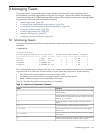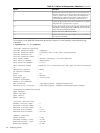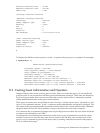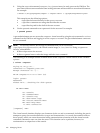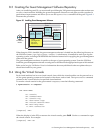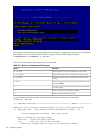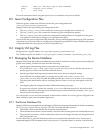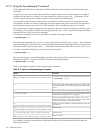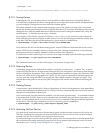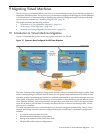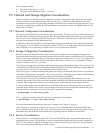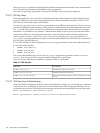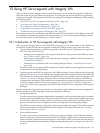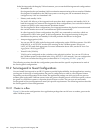# hpvmdevmgmt -l rdev
/dev/rdsk/c10t0d4:CONFIG=rdev,EXIST=YES,DEVTYPE=DISK,SHARE=NO::6005-08b4-0001-15d0-0001-2000-003a-0000
8.7.2.1 Sharing Devices
With Integrity VM, you can allow devices to be specified as either shared or not shared. By default,
vswitches are configured to be shared. Storage devices are configured to not be shared. As administrator,
you can configure a storage device to be shared by multiple guests.
The SHARE attribute is only checked when booting a guest. If one guest is running with a non-shared
device and another guest attempts to boot using that same device, it is blocked. If multiple guests require
sharing devices, then the SHARE attribute for those devices must be changed to SHARE=YES, using the
modify option, -m, with the hpvmdevmgmt command.
For example, if a device like a physical DVD drive, /dev/rdsk/c0t0d0, must be set up as shared to
allow multiple guests access for Ignite installs, then you can use the following command to modify that
entry after it has been placed into the database by a guest creation or modification:
# hpvmdevmgmt -m gdev:/dev/rdsk/c0t0d0:attr:SHARE=YES
Only read-only devices can be shared among guests. Virtual DVDs and virtual network devices can be
shared. DVDs are not shareable unless you specify otherwise. Sharing virtual devices or the hardware
backing stores must be carefully planned in order to prevent data corruption.
To restrict the vswitch named myswitch so that it is no longer sharable, enter the following command:
# hpvmdevmgmt -m gdev:myswitch:attr:SHARE=NO
This command restricts the vswitch called myswitch to use by one guest only.
8.7.2.2 Replacing Devices
If a backing storage device malfunctions, replace it using the hpvmdevmgmt -n option. The -n option
works onlyfor guest devices. It replaces the existing deviceentry with the new device entry while keeping
all the current guest dependents. Thus, each guest dependent is modified to replace the old device with
the new one. If the device being replaced is a pNIC, use the hpvmnet command to halt and remove the
current vswitches using that pNIC and recreate the same named vswitches using the new pNIC. This
method allows the guests to use the new pNIC through the old vswitch names without modifying the
guests.
8.7.2.3 Deleting Devices
A device entry can be deleted only if it has no dependents. If a device has dependents, those dependents
must be removed beforeyou delete thedevice. The hpvmmodify commandthat removesa device removes
that guest as a dependent on that device.
If, for some reason, the guest cannot be modified, you can use the hpvmdevmgmt -d command to delete
a dependent from a device; however, this command does not modify the guest that is dependent on the
device. Use this method only if you can use the hpvmmodify command on the guests that are dependent
on the device. The following example shows how to remove a guest as a dependent:
# hpvmdevmgmt -d gdev:entry_name:depend:depend_name
8.7.2.4 Restricting VM Host Devices
You must set up restricted devices to ensure that no guest uses devices that are reserved for use by the
VM Host, including the storage devices that the VM Host uses to boot and run. This can also include a
network LAN device to which the host requires exclusive access.
If a volume manager is used for host-specific file systems, then the restricted devices should include both
the volume devices and the underlying special device files to protect both from guest access. For more
information, see “Creating Virtual Storage Devices” (page 61).
8.7 Managing the Device Database 109



